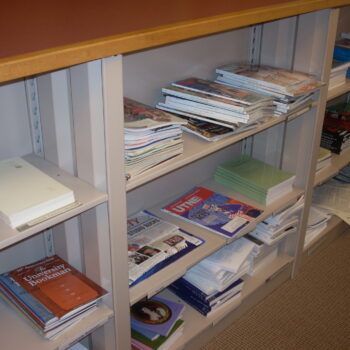
Managing the Stress
[This is as modified version of a coaching concept found in William Bergquist and Agnes Mura. Coachbook: A Guide to Organizational Coaching Strategies and Practices—available on www.amazon.com]
We establish “stress ruts” when exposed repeatedly to real or imagined threats. Unlike the zebra living on the savannah of Africa, we not only respond to the threat of “real lions” (such as threatened attack by another person or the potential of job loss), but also the threat of “imagined lions” (such as feeling insulted by an email we have received or imagining the potential impact of a revenue shortfall in our organization) These ruts are grooved deeper with each stressful event and lead to permanent structural changes in our nervous/hormonal systems. We become increasingly vulnerable (“trigger happy”) to stress. How might a coach assist her client in identifying and even seeking to avoid or reduce the impact of these stress ruts? Below are five tactics and four coaching strategies.
Tactics
Stress can be reduced in one of five fundamental and tactical ways:
(a) avoid stressful situations,
(b) engage in activities that reduce stress once it has occurred,
(c) identify “sanctuaries”: settings and times when and where one can relax and “re-create” (allowing the body to recover from the stress and resulting physiological impact),
(d) obtain a good night sleep (restorative stages of sleep take place only under conditions of deep and sustained relaxation), and
(e) avoid excessive use of substances (including alcohol) that may temporarily elevate mood but soon lead to depression. As a coach we can not only point to these five tactics, but also help our clients identify ways in which they can modify their habits and patterns of behavior in ways that are aligned with these five tactics. An appreciative approach can be engaged by helping our clients identify ways in which, times during which, and places in which they are already operating in a manner that is aligned with these five tactics.
Strategies
Awareness: Point out to our clients that stress ruts continue to grow deeper with each stressful event. We become increasingly “trigger-happy” and these ruts are permanent. They don’t go away when we finally decide to lead a less stressful life. They are enduring neuro-physiological “wounds” that do not heal. When these stress-ruts are established in our bodies, they can only be countered and thwarted by either the complete removal of stress from our life (very difficult in the 21st Century) or by the use of medications that moderate the stress (and place us in the vulnerable position of being drug-dependent and often less vigilant and alert). The third alternative—which is most often taken—is the moderation of the stress through the heavy consumption of alcohol, cigarettes, or over-the-counter drugs. Stress-reduction can’t wait until tomorrow. It is a critical issue to be addressed by our clients (and ourselves) today!
Sunlight: Recently, it has recently been widely acknowledged that “lumens” (light from the sun) trigger neurotransmitters in our brain that are very calming. The absence of sunlight can contribute to depression, anxiety and related mood disorders (often identified as “seasonal” disorders). We should try to expose ourselves to at least 15 minutes of sunlight each day. This exposure should come through our eyes (no sunglasses), though obviously we should not look directly toward the sun and should wear appropriate clothing (including a hat) and sun-block lotion. When our coaching client is preparing for an event that could be quite stressful, we should encourage a brief walk outdoors—it helps to reduce the stress and can be very calming (especially if the setting is beautiful and peaceful, and if fresh air is abundant). If a walk outdoors is not feasible or appropriate, then we should encourage our clients to consider using a “light box” (which provides full-spectrum light), or at the very least find ways to work in a room with natural lighting or full-spectrum lighting. Coaching itself can often be enhanced if the coach and client walk around outside during the coaching session. The client is likely to feel less stressed (because of the lumens, as well as the exercise), and will be inclined to find the coaching relationship itself more satisfying.
Exercise: Exercise is also widely accepted as a practice that can significantly reduce stress. Most animals avoid or reduce stress because they engage in physical activities to escape from or fight with the source of the stress (the proverbial lion). We can similarly reduce the physiological arousal associated with preparation for flight or fight by engaging in physical activities (exercise). While we have known about this fight/flight dynamic for many years, recent research suggests that humans are much more inclined to engage in a third activity (or inactivity) when faced with a threat—this is “freeze.” Like other animals that are not very fast and not very strong, human beings living on the Savannah tried to remain very quiet when confronting a real or imagined lion. This is a smart stance to take for a short period of time—the lion will soon move on and we can once again be active (and “burn off” the stress-related neural and hormonal stimulants that accumulated when we were frightened by the lion). Unfortunately, we often stay “frozen” for a lengthy period of time when confronting imaginary lions, given that these lions don’t leave us, but linger in our thoughts and feelings. As a result, our bodies “burn up” with the excessive chemicals that don’t get burned off when we remain frozen. As coaches we can help educate our clients about the destructive effect of “frozen behavior” and can encourage them to get some exercise—especially after being exposed to real or imagined threats.
Socializing: Finally, we have become increasingly aware that stress can be reduced through the establishment of and the active engagement in social networks. Several neurotransmitters that are activated by “bonding” activities serve (like lumens and exercise) as stress-reducers. This does not mean that the social network must be extensive (there can be too much of a good thing), but it does mean that stress is rarely reduced by long term social isolation. We all need to “cocoon” sometimes and bow out of the social “rat race.” However, sustained isolation produces depression and increases stress. Computer networking doesn’t seem to be sufficient (in fact, extensive time on the computer can actually increase depression). There must be some face-to-face interaction (or at least audio interaction via phone, Skype, etc.) As coaches, we can help our clients identify those interpersonal relationships that are most gratifying and stress-reducing. How do our clients further cultivate these relationships? How do our clients diversify these relationships, so that they find “bonding” experiences at work, at home and in their neighborhood? Many years ago, Robert Bellah and his colleagues wrote about “life style enclaves” which are the new communities in 21st Century societies. These are social networks made up of people with similar hobbies, interests, values and life purposes (ranging from a Polka club to a Porsche car club and from a poker club to a support group for children of alcoholics). As a coach, we can assist our clients in identifying “enclaves” that they would like to join. As appreciative coaches, we can encourage our clients to participate without “guilt” in the enclaves that already bring them pleasure and that help to reduce the stress they inevitably encounter in their busy lives.
- Posted by Bill Bergquist
- On August 15, 2011
- 0 Comment


Leave Reply